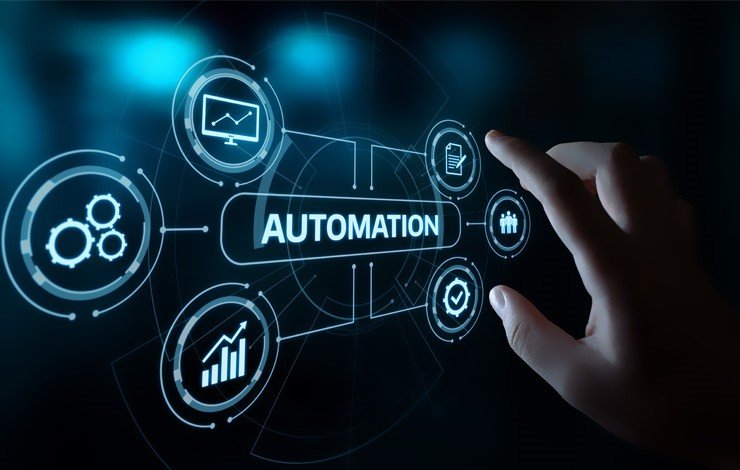In the digital era, the use of RPA is key to enhancing efficiency and competitive advantage for businesses. RPA automates repetitive tasks and allows employees to focus on higher-value tasks. Join akaBot to learn about the basics and the roadmap for effectively deploying RPA in the context of businesses moving towards an “automation culture”.
The Meaning of RPA
Robotic Process Automation (RPA) is a method of optimizing repetitive and high-volume tasks by simulating human interaction with software. RPA bots or programs can efficiently perform tasks like logging in, data entry, calculations, and copying data between systems or processes. When integrated with Artificial Intelligence (AI) and Machine Learning (ML), RPA has the ability to analyze the context of the data being processed more deeply. Technologies like Optical Character Recognition (OCR) help in reading and handwriting; Natural Language Processing (NLP) helps identify specific information such as names, invoice terms, or addresses.

RPA is becoming popular due to its ability to reduce costs, optimize processes, and enhance user experience. Another strength of RPA software is its ability to be deployed quickly without requiring business departments to learn new tools, seek IT support, or change the organization’s basic IT structure.
What do experts say about automation?
Some leaders in the automation industry have given advice on how to start the automation process from a small scale to lay the groundwork for success.
Avoid Common Pitfalls
Those new to automation may worry about common misunderstandings. For example, some manufacturing leaders fear that automation will lead to job losses.
Fredrik Ryden, CEO of Olis Robotics, says: “Fear of job displacement should be acknowledged and taken seriously. But the reality is robots and automation are poor replacements for people. People have a commonsense understanding of the world and the laws of physics that far exceeds the abilities of any industrial robot available today.”
Damon Sepe, segment manager at Rockwell Automation explains: “Across the globe, older workers are moving toward retirement and taking decades of experience and knowledge with them, while a limited talent pool of younger, less experienced workers takes their place. Automation should be viewed as a means to address these workforce challenges and create new opportunities to deploy and support these systems in the field.”
Identify Automation Candidates
Part of developing an automation strategy is identifying the production processes best suited for automation.
Paul Anderson,director of field application engineering for Omron Automation Americas, says: “Removing bottlenecks and errors improves throughput and targeting points of significant operator involvement reduces repetitive work and potential sources of human error.”
According to George Gauthier, senior manager for product marketing at Cognex: “costly and mistake-prone jobs are a good place to start.. Processes that produce excessive amounts of waste, or critical production steps that can lead to problems later.”
Measure Success
There are many ways to measure the effectiveness of an automation solution as well as different types of automation solutions.
Ryden explains: “Collecting standard metrics, such as throughput and uptime, is straightforward using software packages that make it easy to quickly determine whether the deployed solution is performing to specifications.”
Anderson offers a simple approach using financial methods.
“ROI/payback periods can be calculated by looking at the total financial investment and the benefits in throughput compared to before and after. Throughput and quality improvements are just different views of metrics that can help explain how the automation investments are improving the plant. These metrics often mean more to employees than the financial metrics.” he adds further.
RPA Roadmap for Every Business
Start Small
Before deploying RPA on a large scale, businesses should start by automating simple business processes. This not only helps assess the actual effectiveness of RPA but also minimizes the risks associated with the initial investment.
- Survey and Evaluate: CTOs need to identify current processes in the business to find “bottlenecks” and tasks with high automation potential.
- Pilot Test: Choose one or a few small processes to test first. These processes must be simple, have a significant workload, and clear procedures.

Fast Automation
Fast automation focuses on rapidly automating selected processes to quickly see results and encourage widespread acceptance within the organization.
- Choose tools and platforms: Select RPA tools that fit the business needs and size. Evaluate based on features, ease of use, and cost.
- Train Employees: Train and enhance employee skills so they can effectively use RPA tools.
Leverage “Quick-win” Advantages
“Quick-win” in automation involves identifying and automating processes that offer significant benefits in time savings, cost reduction, error minimization, or productivity improvement. This helps boost motivation and support an automation culture in the business.
Some examples of Quick-Win processes
- Automate data entry.
- Automate regular reporting.
- Automate invoice management and payment.
Some Popular Frameworks For RPA
The most successful automation originates from good design. Before starting development, the developer should understand the specific details of the manual process. Ensure that the Process Definition Document (PDD) records the details of the process down to each operation. When the developer uses the PDD as a foundation to design the automation solution, it ensures that all automated processes are created consistently and in an organized manner. The framework starts with a high-level visual architecture overview and then allows developers to delve deeper into the specific details of each process.
1. Robot Framework
Robot Framework is an open-source framework widely used for automating various tasks, not just web applications. It’s known for its:
- Keyword-Driven Approach: Tests and automation scripts are written in a keyword-driven style, making them easier to understand for testers with minimal programming experience. Keywords can be created using Python or other languages like Java (Jython) or C# (.NET).
- Flexibility: Robot Framework can be extended to automate various tasks beyond web testing through external libraries. For example, it can interact with databases (using libraries like robotframework-databaselibrary), mobile apps (using AppiumLibrary), and even legacy systems.
- Ease of Use: Robot Framework uses a human-readable syntax, making it easier to learn and maintain compared to frameworks requiring complex coding.
2. TagUI
TagUI is a free and open-source RPA (Robotic Process Automation) tool that stands out for its simplicity and ease of use. It’s particularly well-suited for beginners and those with limited coding experience. It’s known for its:
- Ease of Use: With its visual selector and JavaScript support, TagUI lowers the barrier to entry for RPA development.
- Lightweight and Efficient: TagUI is a lightweight tool that doesn’t require heavy installation or complex configurations.
- Open-Source and Free: TagUI’s open-source nature and free availability make it an accessible option for individuals and organizations.
3. REFramework
REFramework (Robotic Enterprise Framework) is a popular open-source framework used for Robotic Process Automation (RPA) software development in UiPath Studio. It provides a standardized structure and best practices for building robust, scalable, and maintainable RPA bots.
The main benefits of REFramework include:
- Increased productivity: REFramework helps developers build RPA bots faster and more efficiently by providing pre-designed templates and libraries.
- Improved maintainability: REFramework encourages structured and comprehensible code writing, making it easier to maintain and upgrade RPA bots in the future.
- Enhanced reliability: REFramework includes strong error handling mechanisms and logging features to ensure stable and reliable operation of RPA bots.
- Scalability: REFramework is designed to be easily scalable to meet the growing automation needs of businesses.
Each framework offers unique features and advantages, catering to different testing needs and preferences. Choose the one that best fits your project requirements and team expertise.
Conclusion
Deploying RPA in a business is not just a technology project but also a cultural change. To be successful, business leaders need to play an active role in building and maintaining a positive “automation culture,” where people not only accept but are excited about using technology to improve work performance. Start with small steps, push for quick automation, and leverage the benefits of “Quick-win” processes to foster an environment conducive to automation.
References
RPA Development — A Step By Step Guide for 2024
How To Implement Robotic Process Automation (RPA) In Your Business: A Step-By-Step Guide
Small business automation: 5 quick wins
Getting started with automation
Get Some Quick Wins with RPA Bots
Top 10 Test Automation Frameworks
Starting Small with Automation: Advice from Industry Giants
The top 5 open-source RPA frameworks—and how to choose

